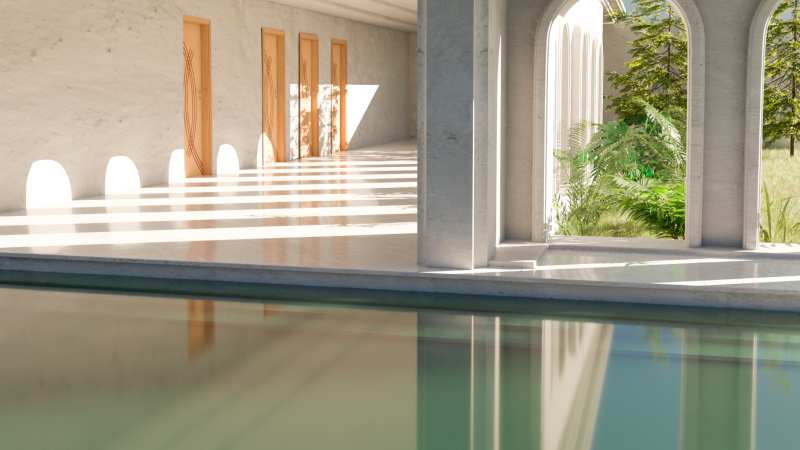When you think about your dream backyard, chances are you picture more than just a rectangle filled with water. A truly exceptional pool doesn’t exist in isolation—it flows naturally from your home’s architecture, creating a unified outdoor space that feels both intentional and inviting.
Harmony in Design: Letting Architecture Lead
Your home’s architectural style sets the tone for everything that follows, including your pool. A mid-century modern home calls for clean lines and geometric shapes, while a Mediterranean villa pairs beautifully with organic curves and natural stone. Ignoring this relationship creates visual discord that’s hard to shake.
Modern and Contemporary Homes
Contemporary architecture thrives on simplicity and precision. Pools that complement these homes often feature rectangular or L-shaped designs with sharp edges and minimal ornamentation. Infinity edges work particularly well here, creating that seamless transition between pool and horizon that modern design celebrates. Water features, if included, tend toward sleek spillways rather than elaborate waterfalls.
Traditional and Colonial Architecture
Classic architectural styles call for more formal pool designs. Rectangular pools with rounded corners, often centered on the property’s axis, create symmetry that echoes the balanced proportions of traditional homes. Stone coping and decorative tile work add refinement without overwhelming the space. These pools often incorporate separate spa areas or raised bond beams that add subtle elevation changes.
Mediterranean and Spanish Revival
Curved edges and freeform shapes feel at home alongside Mediterranean architecture. These pools can incorporate grottos, rock features, and multi-level designs that mirror the textured stucco and clay tile roofs above. The goal is to create something that feels discovered rather than imposed—a natural extension of the home’s romantic character.
Material Consistency: Creating Visual Flow
The materials you choose for your pool should create dialogue with your home’s exterior. This doesn’t mean everything needs to match exactly, but there should be clear visual threads connecting the spaces.
Deck Materials
Your pool deck is the largest surface area surrounding the water, making it crucial for establishing continuity. If your home features limestone or travertine accents, incorporating these natural stones into your deck creates immediate cohesion. Homes with brick exteriors might echo that warmth with pavers in complementary earth tones. Modern homes with concrete or steel elements often pair well with poured concrete decks, stamped concrete, or large-format porcelain tiles.
Coping and Tile
Pool coping—the cap along the pool’s edge—provides another opportunity for material harmony. Natural stone coping works beautifully with homes featuring stone facades, while brick coping complements traditional architecture. The waterline tile, though small in scale, shouldn’t be an afterthought. Glass tiles can reflect the windows of a contemporary home, while ceramic tiles in Mediterranean patterns reinforce that architectural style.
Surrounding Structures
Pergolas, cabanas, and outdoor kitchens near your pool should share architectural DNA with your home. Use matching or complementary roofing materials, similar column styles, and coordinating paint colors. These structures frame your pool area while reinforcing the connection to your main residence.
Maximizing Space: Smart Design for Smaller Properties
Not everyone has sprawling acreage for a resort-style pool, but limited space doesn’t mean limited possibilities. Thoughtful design can create a pool that feels proportionate and purposeful, even on compact lots.
Scale Appropriately
The biggest mistake in small-space pool design is going too large. A pool that dominates your yard creates claustrophobia rather than luxury. Instead, consider a smaller footprint with features that maximize enjoyment—a tanning ledge for lounging, a swim jet system for exercise, or a raised spa that provides visual interest without consuming square footage.
Use Vertical Space
When horizontal space is limited, look up. Raised pools or those built into sloped yards can create dramatic visual impact while preserving usable yard space. Raised walls also provide seating areas and can incorporate water features that add movement without requiring additional footprint. Vertical elements like tall plantings or privacy screens draw the eye upward, making spaces feel larger than their measurements suggest.
Integrate Multi-Functional Elements
Every element should earn its place in a small yard. Low walls that double as seating areas, built-in planters that define spaces without blocking views, and lighting that serves both safety and ambiance all contribute to efficient design. If you’re working with swimming pool contractors in Salt Lake City or elsewhere, discuss features like swim-up bars or integrated fire features that add value without sprawl.
Extend Indoor Spaces Outdoors
Create the illusion of expanded space by designing your pool area as an extension of indoor living areas. Large sliding glass doors that open completely, consistent flooring materials that flow from inside to outside, and outdoor furniture that mirrors your interior style all blur the boundaries between spaces. This makes both areas feel more generous.
Conclusion
A pool designed in conversation with your home’s architecture becomes more than a seasonal amenity—it’s a permanent part of your property’s character and value. This integration requires looking beyond current trends to consider how spaces work together holistically.

